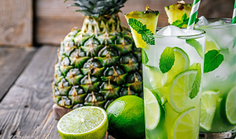The Dirty Dozen + 20 Foods to Always Buy Organic

Why Does Pesticide Use Matter?
Each year, the US uses nearly one billion pounds of pesticides, the majority of which are used to protect crops against damage from insects and disease. While pesticides help to increase immediate crop yields, they pose a significant threat to human and environmental health in the long term. Cancer, birth defects, and infertility are just a few of the side effects linked to exposure to pesticide residue.

What is the Dirty Dozen?
The Dirty Dozen is a term recently coined by the non-profit Environmental Working Group (EWG), a non-profit consumer organization, for the purpose of labeling the twelve most pesticide-laden fruits and vegetables available for purchase in the US. According to an EWG representative, the risk of pesticide exposure is reduced by 80% when purchasing organic foods. See the next slides to learn more about pesticide use, the Dirty Dozen list, and why the Dirty Dozen aren’t the only foods you should be buying organic.

Apples
Apples have been listed at the top of the EWG’s Dirty Dozen list for the past five years for a couple of reasons: first, 80% of apples grown in the U.S. are treated with diphenylamine (DPA) to increase their shelf life. While diphenylamine is not officially on the American Cancer Society’s list of known carcinogens, the chemical has been linked to kidney damage, liver damage, and fetal defects among other serious health conditions. The known risks of DPA are so severe that the European Union has already banned the use of the chemical for agricultural purposes. Second, apples are one of the most common fruits in the US, making the risk for pesticide exposure even higher - each person in the US consumes an average of 42.5 pounds of apple products each year!

Potatoes
Potatoes are also a staple of the EWG’s dirty dozen. Potatoes are root vegetables, meaning they grow underground and serve the functions of water uptake and nutrient storage for the above ground parts of the plant. To combat the risks of growing underground, such as fungal infection and damage from soil insects, conventional potato-growers apply high amounts of pesticides to their crops. The USDA pesticide data program has found 35 varieties of pesticides on potatoes. Of the 35 varieties found, 6 are likely to be carcinogens, 12 are suspected to interrupt with hormone function, and 13 are toxins that affect neurological and/or reproductive development.

Peaches
Peaches have been just under apples at the top of the Dirty Dozen list for several years. The USDA found a startling 62 different pesticide residues on peach crops, 7 of which are known carcinogens, 24 of which are hormone disruptors, and 21 of which are neuro/developmental toxins. Part of the reason peaches make the top of the list is because their paper-thin skin doesn’t provide much protection against chemicals, and as a result pesticides are absorbed directly into the fruit.

Nectarines
Nectarines are close to peaches in both appearance and rank on the Dirty Dozen list. The USDA found significantly fewer varieties of pesticides on nectarine crops than on peach crops – 33 as compared to 62 – however, the found varieties were highly used and pose serious health risks. The most commonly used pesticide was formetanate hydrochloride, a known neurotoxin that can cause nausea, vomiting, excessive sweating, weakness, and tightness in the chest.

Eggs
Conventional eggs are mass-produced in industrial hen houses, where crowded and dark conditions increase the likelihood of disease. As a result, hens are given large amounts of antibiotics to prevent infection, as well as growth hormones to speed their readiness to lay eggs. The antibiotics kill off bacteria, at first, but the bacteria eventually adapt and grow back stronger, creating strains of “super bacteria” that are resistant to antibiotic treatment. When eggs are first laid, they are naturally covered in a thin, antibiotic coating known as a “bloom.” However, when eggs are washed in preparation for the supermarket, this protective coating gets washed off, making the shell porous and the egg susceptible to infection with these potentially deadly “super bacteria.” To learn about the health risks of added growth hormones, read forward to the Dairy slide. Want to play it safe? Buy Pasture-Raised eggs - where hens have space and live decent lives outside in fresh air.

Berries
Strawberries, raspberries, and blueberries all made EWG’s dirty dozen list. In order to meet the now year-round demand for berries, farmers use a dangerous class of pesticides known as fumigants, which, among other pesticides, are sprayed over the entire field prior to planting. Some of these chemicals are absorbed into the berries, and others go airborne, putting farm workers and nearby communities at risk. One such airborne chemical, methyl bromide, can cause side effects such as heart palpitations, jaundice, and respiratory failure. It is so dangerous that there was an international treaty to stop its use by 2005; methyl bromide use has since decreased, however, strawberry farmers in California continue to use it today.

Celery
Also high on the Dirty Dozen list is celery. The USDA found an alarming 64 varieties of pesticide residue in celery, 10 of which are known or probable carcinogens. Celery is famous for containing so few calories that it’s possible to actually burn calories by eating it. This is largely due to its high water content. It’s this high same water content that allows pesticide residue to be absorbed directly into the celery stalk, making it impossible to wash off.

Ground Meat
Like large-scale conventional egg production, large-scale conventional meat-production involves consistent use of preventative antibiotics to fight the spread of infection. However, these antibiotics are not able to kill off all of the bacteria and ultimately breed antibiotic resistant “super-bacteria.” According to Consumer Reports, it’s hard to find a sample of ground meat that doesn’t have some sort of super-bacteria in it. A 2013 report found that 90% of raw ground turkey samples contained one or more varieties of these super bacteria, including the potentially deadly staphylococcus aureus. Want to be healthy? ONLY eat certified-organic, humanely-raised meat.

Leafy Greens
The Environmental Working Group lists leafy greens on the Dirty Dozen “Plus” list because they are slightly less pesticide-laden than the Dirty Dozen foods, but still contain high amounts of these dangerous chemicals. The USDA found 55 different varieties of pesticides in kale samples nationwide, 52 varieties in lettuce samples, and 54 in spinach samples.

Milk + Dairy Products
Many conventionally-raised dairy cows are given growth hormones such as bGH, rbGH, and bST so that they reach maturity faster and are able to produce more milk. These growth hormones remain in the cow’s milk, and are later ingested by people consuming dairy products. The problem is that growth hormones used on dairy cows are “hormone-disruptors” and can interfere with the regular functioning and development of the reproductive system. A potential consequence of this is early-onset or “precocious” puberty in girls, in which signs of puberty begin as early as ages 8 and 9. What's the fix then? ONLY drink organic milk! Or better yet, drink almond or coconut milk.

Bananas
Bananas are not included on the dirty dozen list, largely because their thick, inedible peel protects the fruit from pesticide residue contamination. However, bananas require an immense amount of pesticide use during cultivation, resulting in habitat degradation in the tropical countries where they are produced, as well as pollution of shared oceans and air. One of the chemicals used on banana plantations is chlorpyrifos, which has been linked to stunted brain development, paralysis, and muscle tremors.

Cherry Tomatoes
The USDA has found 69 different types of pesticide residue on cherry tomato crops, 20 of which are suspected hormone disruptors, 9 of which are known neurotoxins, and 22 of which are known honeybee toxins. Honeybee toxins pose a particularly dangerous environmental threat, because they can wipe out entire honeybee hives in only a few months. Largely due to pesticide use, the honey bee population in the US has halved since the 1940s. Honeybees are natural pollinators and are essential to plant reproduction – if the population continues to decline, there could be serious consequences for ecological habitats.

Bell Peppers
Bell peppers are a steady member of the Dirty Dozen, and for good reason! Just one bell pepper could contain more than a dozen different pesticide residues, which are likely to be carcinogenic. Of the 53 types of pesticides found on bell pepper samples by the USDA, 11 are known carcinogens.

Coffee
It’s easy to let beverages slip under the radar when you’re thinking about going organic – but you’ll want to reconsider what you’re drinking after hearing this: Coffee is one of the most chemically treated crops in the world! Every acre of coffee is treated with about 250 pounds of chemical fertilizers and pesticides, and the residues of these substances make their ways into our morning brews. When you take the amount of coffee Americans consume into consideration, nearly 600 million cups each year, the chemical exposure starts to add up.

Corn
The No. 1 crop grown in the U.S. is corn, and nearly all of it — 88 percent — is genetically modified. In addition to being added tocountless processed foods, genetically modified corn is also a staple of animal feed. Genetically modified (GM) corn comes in two forms: the first is corn that has been modified to be resistant to the application of a particular herbicide/pesticide; the second is corn that has been modified to actually emit a pesticide by itself! The full effects of genetically modifying foods are a topic of debate. However, many believe that GM foods can decrease the nutritional value of food and cause cancer.

Snap Peas
Snap peas are a surprising member of the Dirty Dozen list. According to the Environmental Working Group, a single snap pea sample could contain 13 different types of pesticides. Domestic snap peas were found have slightly fewer pesticides than imported snap peas, so if you can’t find fully organic peas, try for ones that were grown in the USA.

Tofu/Soy products
Like corn, a large majority (94%) of soy is genetically modified (GM) to increase productivity. There is a growing body of evidence that suggests that GM soy poses health risks, including studies that have shown a significant increase in soy allergies following the introduction to GM soy. The United Kingdom saw a 50% increase in soy allergies almost immediately after it began producing GM soy. Parts of the UK, along with other European Union countries, have since banned the production of GM products.

Peanut Butter
Conventional peanut butter is often made with palm oil, which is produced with one of the most destructive agricultural/processing methods around. According to the World Wildlife Federation (WWF), for every metric tonne of palm oil produced, 2.5 metric tonnes of a toxic byproduct known as ‘effluent’ are produced. Effluent then finds its ways into water supplies and poses significant threats to human, animal, and ecological health. Palm oil is also extremely high in saturated fat and has been linked to heart disease. Choose organic brands of peanut butter without any added palm oil for a healthier and more sustainable option.

Hot Peppers
The USDA found 75 varieties of pesticides on hot pepper samples – more than any other food on the dirty dozen list. However, the quantities of these chemicals are relatively small. Like greens, hot peppers are included in the Dirty Dozen “Plus” list because they have lower levels if pesticides than many other foods but still can pose a health risk.










